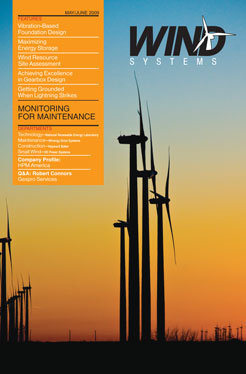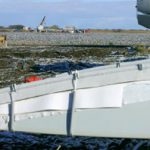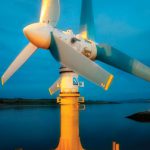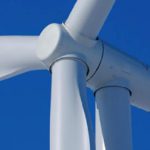Increasingly, the energy future is blowing in the wind. Clean wind energy is America’s fastest-growing energy source, expanding by a record 8,300 megawatts in 2008, but a number of challenges must be met to ensure wind achieves its full promise, with intermittency representing one of the biggest obstacles. By its nature wind is a variable resource that isn’t so easy to integrate with the grid in large quantities. The wind blows when it will and generally picks up at night, while electric demand peaks during the day. These basics have profound implications for the economics of wind energy. In today’s volatile energy markets, wind energy producers can find themselves sometimes having to pay to sell their power, or suddenly curtailed as a result of transmission congestion or other factors.
Given such issues, there has been a search for technical solutions that involve storing energy for use when it is most needed, with the goal of better integrating renewable energy into the grid and improving its economic viability. In this way renewables can become more manageable, predictable, and profitable resources.
“Anything that does commercial-scale energy storage is huge,” says John Gardner, Ph.D., associate vice president of Energy Research, Policy, and Campus Sustainability at Boise State University. “It can completely change the economic prospects of a wind farm.”
Enter CAES 2, the second generation of compressed air energy storage technology. CAES 2 technology stores low-cost, off-peak energy for release when needed, which is generally during peak hours when the energy has more value. In situations where there is a sudden loss of renewable generation, CAES 2 can come to the rescue by providing power almost at a moment’s notice. It also can serve as a standalone intermediate generation resource for capturing energy arbitrage, capacity payments, and ancillary services.
A Green Technology
CAES 2 is designed not only to be an efficient solution to support wind power, but an environmentally sound one as well. As renewables become a larger and larger part of U.S. energy supply, compressed air energy storage with CAES 2 will be important to help wind energy achieve its full promise and value.
“Energy storage is the missing piece of the puzzle for a green, affordable, and reliable electric grid for the 21st century,” says Roy Daniel, CEO of Energy Storage and Power, which developed and delivers the patented second-generation CAES units. “CAES 2 is an enabling technology for efforts to provide more clean, renewable power, fight climate change and move our nation toward energy independence.”
While not new, the technology behind CAES has significantly improved. Almost 20 years ago Michael Nakhamkin, Ph.D., designed the nation’s only CAES plant, which was a 110-megawatt facility in McIntosh, Alabama. While the plant continues to operate successfully, Nakhamkin has taken the technology to another level by using multi-sourced components to reduce costs, enhance reliability, and improve environmental performance. “It’s a simple concept, using a proven standard based on off-the-shelf components,” he adds.
The key is the process used by CAES 2 to store compressed air and transform it cleanly and efficiently back into electricity. The first step is to use off-peak energy to run a compressor train and create compressed air, which is usually stored in an underground cavern. During peak hours the air is released and heated to power an expansion turbine/generator (a modified steam turbine) to produce electricity. Heating the air is necessary because stored air cools as it is expanded in the turbine.
CAES 2 technology has an integrated recuperator and air expander that makes use of exhaust heat from the combustion turbine, eliminating the need for a separate burner. This advance significantly reduces the natural gas used in the process to lower costs and emissions. It is estimated that a CAES 2 storage unit would use approximately 60-percent less fuel than an open cycle combustion turbine, and 40-percent less fuel than a combined cycle unit. Moreover, the air storage cycle is totally green during regular operations to further benefit the environment. Ambient air is stored, and ambient air released. Figure 1
Flexibility, Scalability
Other improvements add to the attractiveness of CAES 2 as a practical energy storage solution and grid integration tool. Perhaps the most important is the flexibility to match generation to load. A CAES 2 unit is designed to start in less than 10 minutes and offers exceptional operating flexibility. “This technology covers the whole spectrum, from load leveling and ramping to frequency control, so you can have what you need to have in terms of load-matched generation,” Daniel observes. “CAES units can be instrumental in managing renewable energy output to create a highly valuable, firm, dispatchable product.”
In addition, CAES 2 units are scalable, and can range from 15 megawatts to 430-plus megawatts without significantly altering their operational qualities. In fact, the respective size of the CAES 2 unit is primarily based on the size of the combustion turbine. For example, an 80 MW combustion turbine can be used to produce a 230 MW CAES 2 unit. Combustion turbines can be existing or new.
Larger CAES units can be accommodated with underground compressed air storage in a relatively tidy footprint. For example, a 300-megawatt unit would require some 22 million cubic feet of space, or about a third the size of a football stadium. At full capacity, a reservoir of this size could produce enough electricity to power around 200,000 homes for eight hours. According to the Electric Power Research Institute (EPRI), the geology of most of the United States is suitable for storing compressed air underground.
Smaller versions of the technology using above-ground storage provide cost-effective alternatives to utility-scale batteries and other electronic systems for energy storage. These CAES 2 units offer utilities a low-cost, low-carbon option for reinforcing their transmission systems and providing distributed generation coupled with energy storage.
Multiple Applications
Wind is not the only resource that CAES 2 technology can benefit. It is suitable for solar and other renewable energy developers, independent power producers, electric utility companies, and transmission owners. One innovative use of CAES 2 is as a bolt-on for an existing combustion turbine. Green compressed-air power adds to the combustion turbine’s output but not to its emissions for a better environmental profile, while providing additional megawatts of stored energy for load management.
Compressed-air storage could have an important role as a supplement to baseload resources, such as carbon-free nuclear power, according to Arshad Manshoor, EPRI’s vice president of power delivery and utilization. “Nuclear is an inherently stable source of power, so stable that we don’t want to ramp it up and down,” he explains in The Energy Daily. “Nuclear will need storage at night, when demand is low, and we really are looking at hundreds of megawatts of storage to meet that need.
“We asked the question ‘if we need bulk storage in our portfolio in the next five to 10-year timeframe, what technologies are available?’ There are lots of options,” he says, “but we need options that are cost effective and deployable in that timeframe. The only answer we were left with is compressed air.”
Nakhamkin sees CAES 2 as ready to provide wind and other energy producers with a range of market benefits including higher utilization, stability, and power quality. “We have learned a lot about the logistics of compressed air energy storage, and I believe the time is right technically, environmentally, and economically for a large-scale deployment of CAES 2 technology,” he says. “The technology has evolved to the point where it can be critical to helping this nation meet its growing energy needs while decreasing carbon emissions from the electricity sector.”
Conclusion
Technology that improves the reliability of wind or other intermittent renewable energy resources fits with efforts to green America’s energy picture and improve energy security. Indeed, it can be a key to reducing dependence on fossil fuels and imported energy. Clean, efficient energy storage with CAES 2 can accelerate wind energy’s continued growth and success to speed the arrival of America’s green, sustainable future.
To learn more about Energy Storage and Power, LLC, call (866) 941-2237, e-mail info@energystorageandpower.com, or go to www.energystorageandpower.com.








































